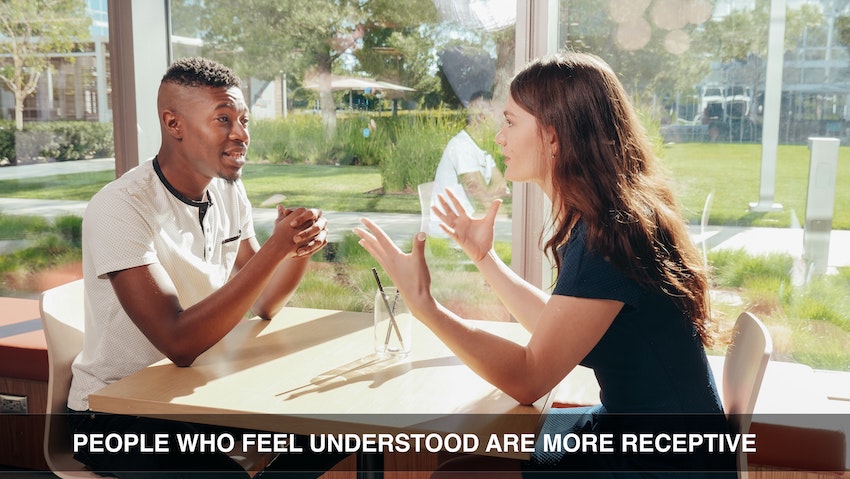How To Be Calmly Assertive
Unlock your voice with confidence and calm
Refine your communication skills by learning to harness your emotional intelligence with one of the UK's most acclaimed management training courses.
Why Choose This Training?
More Than Just A Course Of Lectures
What gets in the way of developing and holding on to new communication skills are old habits of thinking and speaking. Even if the advice is very good the reason why it rarely sticks are the mental habits people inevitably revert to, especially under pressure.
Unlearning those old habits and internalising a more effective and lasting approach to communication needs more than a short course of lectures on how to do it.
What Makes This Training Stand Out?
What makes this training stand out is the exceptional support through one-to-one coaching sessions and continuous feedback. Changing behaviour is not an easy task as old habits are hard to break.
With a 40-year track record we can help you cultivate practical skills, and build your confidence to so you can successfully navigate real-world challenges, ensuring lasting behavioural improvements.
Testimonials
Join thousands of participants getting results
"What I love about this course is that I didn't just learn about the topic, this course is about ME. I'm confident I can reliably use my new skills, even when under pressure".
![]()
"A lesson for life! The power of effective communication is incredible when one masters the skills "listening with empathy" and "speaking assertively"
![]()
Clients We Have Worked With
Well-known companies who have used this course again and again, over many years
Course Summary
Training Objectives
Struggling to get your point across without causing an uproar can be tough. Assertive communication is the key to maintaining healthy relationships while standing up for yourself. This training course offers simple strategies to help you communicate confidently and calmly, ensuring you're heard without stepping on toes.
Develop Your Emotional Intelligence
You will learn a set of powerful emotional intelligence communication techniques so that you can manage difficult conversations, handle challenging situations, build relationships and set firm boundaries.
Transferable Skills
The goal of this training is to equip you with the tools you need to build strong, lasting relationships in your professional life, although because these skills are so transferable many clients report vast improvements in their personal relationships as well.
Develop Skills
This is a skills development rather than just a theoretical programme, so the emphasis throughout will be on you taking turn after turn, practising your skills, while receiving feedback and coaching about your effect on others.
Repeated Practice and Feedback
In your coaching sessions you will be helped to practise dealing with the kinds of situation you find challenging, again and again, until you are confident you can do it successfully.
Video Analysis
We'll combine practical, hands-on experience with video replay and analysis and discussion of the principles involved to help you gain both skills and understanding. Special attention is paid to your individual training needs, so you can practise your skills in real-life situations that you have to handle at work.
Sustained Change
That's why as well as your place in a small group, this training includes a generous amount of private and confidential one-to-one coaching sessions online, spread over several months, ensuring an exceptional level of support. This will ensure the changes you make are sustained over a longer period of time and any obstacles are overcome. Choose between online training available worldwide, or in-person face-to-face courses in the UK.
Course Dates and Price
For a list of upcoming course dates (for online coaching and face-to-face training), the locations of the next 3-day public courses in the UK and pricing Click here.
Free Initial Session
This initial coaching session serves as an introduction to the "Skills with People" course, allowing you to understand the course's relevance and effectiveness for your specific needs before committing to it.

Understanding Assertiveness
Understanding assertiveness is crucial for effective communication. It empowers you to express your own needs and opinions without undermining others'.
What is Assertiveness?
Assertiveness is the skill of expressing your feelings, opinions, and needs in a clear and respectful way. It allows you to stand up for yourself while maintaining healthy relationships with others.
Unlike aggressive behaviour, which aims to dominate or control, assertiveness respects both your rights and those of others. This approach fosters open communication, enhancing personal growth and self-esteem.
It involves using direct language to communicate your desires effectively without causing offence or harm. Practicing assertiveness helps you navigate difficult situations calmly, making sure your voice is heard.
Key elements include employing active listening skills, formulating statements that explain how you feel and why, for clarity in expressing personal feelings and thoughts, and staying calm even when under pressure.
Through such strategies, assertiveness becomes a powerful tool in balancing one’s own needs with respect for the perspectives of other people.
Assertive vs. Passive Behaviour
Understanding the distinction between assertive and passive behaviour is crucial for effective interpersonal communication. Below is a table that summarises the key differences:
|
Assertive Behaviour |
Passive Behaviour |
|
Expresses thoughts, feelings, and needs directly. |
Avoids expressing thoughts, feelings, and needs. |
|
Respects own rights and the rights of others. |
Puts others' needs before own, often neglecting personal rights. |
|
Seeks win-win situations. |
May lead to feelings of resentment due to unmet needs. |
|
Maintains a calm and confident tone. |
Communicates with hesitancy and submissive tones. |
|
Uses open body language. |
Displays closed or withdrawn body language. |
|
Feels empowered and in control. |
Feels powerless and taken advantage of. |
Assertive vs. Aggressive Behavior
When discussing communication styles, it's crucial to distinguish between assertive and aggressive behavior. These styles impact our interactions significantly. Check the table below for a clear comparison.
|
Assertive Behaviour |
Aggressive Behaviour |
|
Expresses needs and wants confidently |
Dominates or controls others to meet personal needs |
|
Respects own rights and the rights of others |
Ignores or violates the rights of others |
|
Communicates feelings openly and honestly |
Uses intimidation or humiliation |
|
Strives for a win-win situation |
Aims to win, regardless of the cost to others |
|
Uses calm and even tone |
Often employs a loud, demanding, or overbearing tone |
|
Body language is open and approachable |
Body language can be threatening or invading personal space |
|
Seeks to understand the perspective of others |
Shows little interest in the opinions or needs of others |
Assertive vs. Passive-Aggressive Behaviour
Understanding the difference between assertive and passive-aggressive behaviour is crucial in improving communication skills. Below is a table that highlights the key differences:
|
Assertive Behaviour |
Passive-Aggressive Behaviour |
|
Expresses needs and feelings directly. |
Expresses feelings indirectly, often through sarcasm or backhanded compliments. |
|
Respects both personal and others' rights. |
May violate others' rights through manipulative tactics. |
|
Seeks solutions to conflicts. |
Avoids direct confrontation, leading to unresolved issues. |
|
Uses clear and straightforward communication. |
Relies on ambiguous communication, causing confusion and misunderstanding. |
|
Maintains self-control and calmness. |
Displays resentment and frustration indirectly. |
|
Builds and maintains healthy relationships. |
Often damages relationships due to lack of genuine communication. |

The Benefits of Being Calmly Assertive
Embracing calmly assertive behaviour boosts your ability to handle stress and enhances the way you communicate, opening doors to healthier relationships and increased self-confidence.
Better Stress Management
Being calmly assertive helps in managing stress effectively. It enables you to communicate your needs and boundaries clearly, reducing misunderstandings and conflicts. This clarity in communication fosters a positive environment both at work and in personal relationships, cutting down on stress levels significantly.
Assertiveness also empowers you to handle aggressive communication or passive behaviours from others without losing your calm.
Practicing assertiveness skills involves recognising when to say no and how to express your thoughts without feeling guilty or anxious. By maintaining healthy relationships through open communication, individuals find it easier to navigate stressful situations.
They learn not just to respond with anger or aggression but with confidence and self-control. Moving forward, improving your communication style will further enhance these benefits.
Improve Your Communication Style
To improve your communication style, practice active listening. This involves focusing intently on what the other person is saying without formulating your response while they're still talking.
By doing this, you show respect and open-mindedness, key components in maintaining healthy relationships. Use statements that express “How you feeL”, “What that’s about”, and “Why you feel that way” to express how you feel without blaming or accusing others, which can help prevent conflicts from escalating.
Develop a calmly assertive tone by controlling your emotions during conversations. Breathe slowly to stay calm and think before you speak to keep the discussion productive. Good posture and eye contact also play significant roles in demonstrating confidence without appearing aggressive.
These adjustments in how you communicate can significantly improve interactions with others, making it easier to establish common ground and set boundaries respectfully.
How to Be Calm but Assertive
Learning to marry calmness with assertiveness involves mastering the skill of expressing your needs and opinions confidently, without tipping into aggression or passivity. Explore further to uncover how this powerful combo can transform your interactions and relationships.
Preparing Mentally
To prepare mentally for calmly assertive communication, it's crucial to identify areas within ourselves that need work. This involves reflecting on past experiences where we might not have been as assertive as we wished.
By recognising these moments, we can better understand our reactions and the triggers that make us feel less confident in standing up for ourselves.
Building self-confidence is another essential step in preparing mentally. Confidence helps us maintain a calm demeanour during conversations. It also assists in the effective use of statements about your feelings, which are vital for expressing yourself without making others defensive.
This process doesn't happen overnight but gradually improves as we become more aware of our strengths and how to leverage them in different styles of communication.
Practicing Active Listening
Active listening plays a crucial role in being calmly assertive. It requires full attention to the speaker without interrupting, showing understanding through body language like nodding, and reflecting back what has been said to ensure clarity.
This form of communication helps prevent misunderstandings and builds trust between individuals, making it easier to maintain healthy relationships.
By engaging in active listening, you demonstrate respect and empathy towards others' viewpoints. This approach encourages open dialogue where all parties feel heard and understood.
Use facial expressions that convey attentiveness and interest. Make sure your responses are thoughtful, taking into account what the other person has expressed before sharing your perspective or setting boundaries.
Active listening not only improves interactions but also boosts self-confidence as it equips you with better tools for communicating effectively in various situations.
Using "I feel …” Statements
Using "I feel …” statements is a powerful tool in assertive communication. It allows you to express your feelings, thoughts, and needs clearly without blaming or criticising others. For example, say "I feel upset when meetings start late" instead of "You make me angry when you're always late." This approach helps maintain respect and avoids escalating tensions.
It shifts the focus to your perspective and encourages a healthy dialogue. You take responsibility for your emotions and give others insight into how their actions affect you. By doing this, you set the groundwork for finding a win-win solution that respects both parties' needs.

Maintaining Calm Tone and Body Language
Keeping a calm tone in your voice helps hold the listener's attention without overwhelming them. Speak clearly and at a moderate pace to convey your message effectively. This method ensures that you express yourself with confidence, which is essential for assertive communication.
Avoid raising your voice or speaking too softly as it might send mixed signals about your self-esteem.
Your body language speaks volumes before you even say a word. Stand or sit up straight, maintain eye contact, and keep an open posture to project self-confidence and assertiveness.
These non-verbal cues support your spoken words, making it easier for others to understand and respect your boundaries and messages. Practicing assertive body language helps reinforce the sense of being calmly assertive in various situations.

Setting Healthy Boundaries
Setting healthy boundaries is a key aspect of learning how to be calmly assertive. It enhances your mental health and improves self-esteem by clearly defining what you are comfortable with.
- Identify your limits: Understand and acknowledge your emotional, physical, and mental limits in various situations.
- Communicate your boundaries clearly: Use "I" statements to express your boundaries in a respectful yet firm manner.
- Start small: If setting boundaries feels hard, begin with less challenging situations and work your way up.
- Be consistent: Apply your boundaries consistently to teach others how you expect to be treated.
- Say no when necessary: It's okay to refuse requests or favours that make you uncomfortable or infringe on your time and energy.
- Recognise other options: Understand that people have the right to respond in their own way, but stay firm on your stance.
- Prepare for pushback: Not everyone will respect your boundaries; prepare mentally for such scenarios without giving in.
- Practise self-care: Setting boundaries is a form of self-respect, so reward yourself for maintaining them.
- Seek support if needed: If finding it difficult, talk to someone you trust about ways to enforce your boundaries effectively.
- Re-evaluate regularly: Life changes and so may your boundaries; review them periodically to ensure they still work for you.

Communication Skills
Improving your communication skills significantly boosts self-confidence and self-esteem. You learn to express yourself clearly and listen to others effectively. This not only helps in personal relationships but also makes you more assertive in professional settings.
Use “I feel …” statements to convey your thoughts and feelings without placing blame on others, which leads to a win-win solution for everyone involved.
Active listening is another critical aspect of strong communication skills. It involves fully engaging with the speaker, understanding their message, and responding thoughtfully. Recognising non-verbal cues plays into this as well, as much of our communication is done through body language rather than words alone.
Mastery over these skills ensures that you are heard and understood, paving the way for genuinely assertive interactions.
Assertive Communication Techniques
Building on the foundation of strong communication skills, mastering assertive communication techniques is essential for conveying your thoughts and needs effectively. These strategies empower you to express yourself confidently and respectfully, ensuring you maintain self-esteem while fostering a win-win situation for all involved.
- Use "I fee”l … statements - Make personal statements that express your feelings or needs without blaming others. For example, say "I feel frustrated when meetings start late" instead of accusing others of being always late.
- Practise the Broken Record Technique - If your point isn't getting acknowledged, calmly and repeatedly state your message without getting drawn into arguments or off-topic discussions. This helps in ensuring your message is heard without escalating tensions.
- Actively listen - Show that you value the other person's perspective by listening actively. Nodding and repeating back what you have heard demonstrates understanding and respect.
- Maintain eye contact - Doing so signifies confidence and sincerity, making it more likely for others to take your words seriously.
- Keep an even tone - A calm and stable tone of voice conveys control and assurance, helping to prevent misunderstandings or conflict.
- Be concise - Get straight to the point without unnecessary elaboration. Clear and concise communication reduces confusion and keeps discussions productive.
- Agree to disagree - Recognise when no agreement is possible and respectfully agree to disagree, preventing drawn-out conflicts that lead nowhere.
- Offer solutions - Don't just highlight problems; propose practical solutions as well. This constructive approach encourages positive outcomes from discussions.
- Say no when necessary - Assertively expressing refusal allows you to set healthy boundaries without feeling guilty about prioritising your needs and values.
- Practise empathy - Considering the other person’s feelings fosters mutual respect and understanding, paving the way for more collaborative interactions.

Building Self-Confidence
Self-confidence is a key ingredient in the recipe for calmly assertive behaviour. It roots from believing in one's abilities and value as an individual. To enhance self-confidence, start by acknowledging your achievements, no matter how small they seem.
This practice helps you recognise your strengths and the areas where you excel. Engaging in activities that challenge you also plays a significant role in boosting self-esteem.
Using "I feel …” statements is another powerful tool to assert yourself while building self-confidence. These statements allow you to express your feelings and needs directly without blaming or criticising others, fostering a win-win situation in interactions.
Remember, every time you successfully communicate your thoughts and boundaries using "I" statements, it boosts your confidence even further, making it easier to maintain this positive habit over time.

Body Language
Body language plays a crucial role in projecting calm assertiveness. Your posture, eye contact, and gestures speak volumes before you even utter a word. Stand tall with your shoulders back to convey confidence.
Maintain steady eye contact to show you're engaged and attentive, but ensure it doesn't come off as intimidating. Use open gestures like nodding to signal agreement or understanding during conversations.
Incorporate "I feel …” statements into your body language by matching your words with appropriate actions. For instance, when stating your opinion or need, slightly lean forward; this shows you're invested in the interaction and value the outcome.
Recognise the power of mirroring in building rapport; subtly copying the positive body language of others can create a win-win situation by making them feel more at ease and understood.

How to be calmly assertive FAQs
1. What does it mean to be calmly assertive?
Being calmly assertive is about showing self-confidence and self-esteem in a gentle way. It means you tell others what you need using "I statements" without being too pushy.
2. How can I start being more assertively calm?
Start by recognising your feelings and needs, then express them directly with "I statements." This helps avoid misunderstandings and shows respect for the other person's views, aiming for a win-win situation.
3. Are there different styles of being assertively calm?
Yes, people show their calm assertiveness in various ways—some might softly speak their mind while others use humour or ask questions to open up other options without conflict.
4. What if someone doesn't respond well to my calmly assertive approach?
If they don't get it, stay cool... Remember, you can only control your actions, not others' reactions. Keep practising your style - confidence grows with time!
5. How can I practice assertiveness to maintain healthy relationships? How can practicing assertiveness help me maintain healthy relationships?
Practicing assertiveness is crucial for maintaining healthy relationships because it allows you to express your own needs and boundaries clearly and respectfully. Assertive behaviour involves a balance between aggressive and passive communication styles, ensuring you are honest about your feelings and needs without disregarding those of others. To practice assertiveness effectively, start by recognising your own needs and the importance of expressing them. Use good posture and maintain calm facial expressions to convey confidence. Breathe slowly and stay calm to help manage emotions during the conversation. Setting boundaries is also a key aspect of assertiveness, enabling you to protect your own well-being while respecting the relationship. Remember, assertiveness is about finding a balance that respects both your power and the health of the relationship.
6. What are some tips for becoming more assertively communicative?
To become more assertively communicative, consider the following tips:
Recognise Different Styles: Understand the difference between aggressive, passive, and assertive communication styles. Recognising these can help you adjust your approach to be more balanced and effective.
Stay Calm and Breathe Slowly: Keeping your emotions in check is vital. Practice breathing slowly and staying calm to help maintain composure during conversations.
Use Good Posture and Facial Expressions: Your body language says a lot about your confidence and intentions. Good posture and neutral facial expressions can help convey your message assertively.
Be Honest and Direct: Honesty is key in assertive communication. Clearly express your thoughts, feelings, and needs without being aggressive.
Setting Boundaries: Clearly define and communicate your boundaries. This helps others understand your limits and respects your needs.
Balance in the Relationship: Aim for a balance that respects both your needs and those of others in the relationship. Assertiveness should not be about winning an argument but about maintaining a healthy, respectful relationship.






















